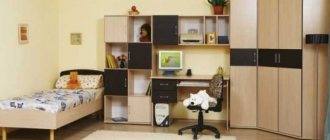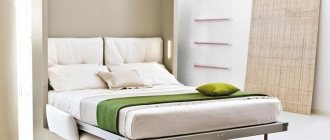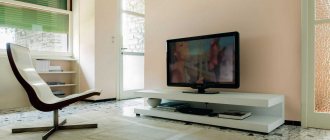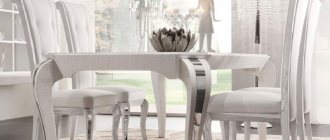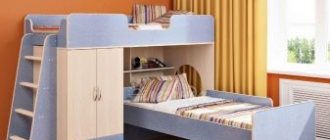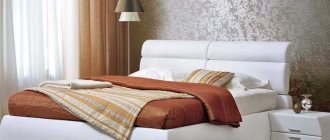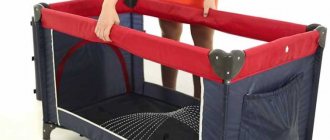0
14346
Large tables take up a lot of space, so they may not fit in all rooms. In addition, they do not fit with any modern designs. For this reason, a table-book is popular among consumers, the dimensions of which allow it to be placed in a small kitchen, living room, even on the balcony. Various materials are used in production, so the cost of products is affordable for people with any income. The furniture is presented in an abundance of textures and colors, which allows you to choose a table to suit different interior styles.
Design Features
The design of such furniture is compact: it involves the presence of 2 or 3 panels connected by hinges. They open up and resemble a book (traditional version). The biggest advantage of the products is the ability to change the usable area of the tabletop when necessary. In just a minute, the surface will double or even triple in size. The canvas can be laid out on one or both sides. At the same time, the dimensions of the table-book when assembled are minimal. Compactness ensures ease of use and storage.
An ergonomic furniture model allows you to make maximum use of the apartment space. The folded structure will look more like a long cabinet, and when unfolded it will become a full-fledged table. This solution is indispensable for small spaces. At the same time, the table of the “book” model is universal, since it can be installed in the kitchen, living room, nursery, and is even suitable for the garden.
From three canvases
From two canvases
Folded
Narrow
Where to put such a table
The advantage of a do-it-yourself table-book based on drawings and diagrams that a person created himself is that you can make furniture to suit any interior. Some people install such furniture in the nursery so that the children have a place to play, but it is enough to lay out the table to create a surface on which the children can both draw, assemble puzzles, and learn their homework.
A table in the living room will allow you to receive guests at any time, and quite a lot. Such furniture is in demand both in offices and stores.
This type of furniture is perfect for studios, lofts and just small apartments.
A folded table-book can be used in the interior as a coffee table, and it can be installed either directly against the wall or in the center of the room or near a window.
A table assembled by yourself will last longer than a budget model, which is comparable in price to this product. Therefore, go for it - and you will enjoy the fruits of your hands for many years and be proud of the result.
Instructions: how to make a table-book with your own hands
When choosing materials for the manufacture of instructions that interest us, remember that the main criteria that determine what they will be are, perhaps,:
- your initial capital;
- and your construction skills.
Exactly what the tables we are interested in, which you make yourself, will look like will depend on what your budget is and what your personal preferences are.
It is also worth thinking about the shape of the future table in advance. So, its tabletop can be:
- round;
- rectangular;
- square;
- oval, etc.
Before you make a table, you need to think about what it should be
Don't forget to take a look at the legs too. They can be equipped with wheels to make the table unfold better, however, in this case, you need to take care of the special stability of the mechanism.
The size of the table is another point that will have to be carefully considered, since you can make a table-book for lunch or work for one person, or you can make it for a whole family who loves to spend their free time eating and communicating with each other. If you have a small child, then the product will need to be made super-stable and not heavy, in case the child accidentally touches it carelessly.
You can immediately make a multifunctional transformer that will attract great attention from guests and family members
Step No. 1 - drawing development
The assembly of any piece of furniture begins with the fact that you develop its drawing. Initially, this may not even be a drawing, but a sketch, that is, the shape and appearance of your future table, embodied on paper or in a computer editor according to the parameters that you have designated for it.
At the very beginning it is necessary to develop a sketch of the future product
After the version drawn on the screen or paper reaches the desired parameters, you will need to begin its detailed disassembly, that is, drawing a real drawing, which will display the main details and required dimensions of the structure being constructed.
You can make your own sketch and also make your own drawing based on it, however, to speed up the work, we suggest that you use the material that we present in this article, or, as a last resort, carry out your own versions of the work by analogy with it.
Drawing of the future table with dimensions, presented in millimeters
From this drawing you can see that the table that we will make has quite standard parameters. Namely:
- height equal to 75 centimeters;
- width equal to 80 centimeters;
- the length of the tabletop when unfolded is 145 centimeters;
- total length when folded is 25 centimeters.
Having outlined the main dimensions, we move on to the preparation of building elements.
Step No. 2 – assembling the necessary materials
Now we need to list exactly what parts our product will consist of, so that it is clearer to you. In principle, everything is quite simple here; we will make up the table from:
- countertops, which are generally composed of three segments;
- sliding legs in the amount of 4 pieces;
- main supporting element.
Now we need to order table parts with the parameters we need from a furniture company
Of course, you can cut all the materials yourself, using, for example, laminated chipboards, since they are best suited for this work. But it’s best if you don’t have, for example, a sawing machine, make a detailed calculation of the parameters of each of them, and order these parts from a furniture company.
We will deal with specific calculations in the next paragraph, but for now pay attention to the table in which we will indicate exactly what parts of the fittings we will need to assemble the desired table.
Table 4. What accessories need to be purchased to assemble the table
| Detail | Quantity in pieces |
| Butterfly loops | Available in 16 pieces |
Straight rollers | Available in 8 pieces |
Self-tapping screws | Needed to attach hinges and rollers, it’s better to immediately buy a set of 100 pieces (4 by 16) |
| Confirmat | You will also need confirmations with parameters 75 by 5; you need to purchase only 45 pieces. |
| Metal corners | Metal corners in the amount of 4 pieces are needed to attach the tabletop to the legs. |
| Adjustable feet | We will also need 4 adjustable supports. |
Step No. 3 – detailed calculation of the size of our parts
So, let's start, perhaps, directly with the tabletop. You need to understand what size it will be. As you remember, it consists of three separate segments, each of which will have its own size. In principle, everything is simple here:
- two wide parts will have a size of 80 by 60 centimeters;
- the thin, narrow part of our tabletop will measure 80 by 25 centimeters.
First, let's calculate the parameters of the tabletop, separately determining the size of its wide or narrow parts
Now we proceed to calculate the size of the main supporting element, also taking into account the fact that it is equipped with sliding legs.
So, take a look at the drawing. The numbers highlighted in blue are those that indicate:
- racks that make up the sidewalls of the common support;
- ribs that give the structure the necessary rigidity.
Drawing needed to detail the parameters of our furniture elements
So, let’s first determine the parameters of the racks. Let's remember the overall height of our product. It is equal to 75 centimeters. The thickness of the tabletop that we are making will be equal to 1.6 centimeters, and the supports, which will subsequently be screwed to the bottom of the racks, will have a height equal to a centimeter. As a consequence, to calculate the height of the racks, it is necessary to calculate the following value: 75 centimeters - 1.6 centimeters - 1 centimeter. As a result, we get 72.4 centimeters.
The width of the part under consideration must be the same size as the similar parameters of the middle table cover, otherwise, instead of a book, you will get a structure that does not want to fold at all.
It turns out that the parameters of our racks will be: 72.4 by 25 centimeters; we only need to make 2 of these racks.
Now let's start calculating the stiffeners.
So, now we need to calculate the parameters of the table stiffeners
Take another close look at our drawing. We will make an indent of 3 centimeters from the racks and from the end part of the tabletop. That is why we will calculate the length of our stiffeners using the following formula: 80 centimeters – 1.6 centimeters – 1.6 centimeters – 3 centimeters – 3 centimeters. As a result, we get a value equal to 70.8 centimeters.
The width of the parts we are interested in should be such that the retractable legs can fit inside this segment of the table. That is why on each side we will leave about 7 centimeters for our needs, and the legs themselves will be made 6 centimeters wide. The remaining centimeter will be given over to the gap, which, as we know, has never bothered anyone.
Each table has stiffening ribs, as they are needed to give it stability
Prices for popular models of screwdrivers
Screwdrivers
So, it turns out that the width of our parts will be 25 centimeters - 7 centimeters - 7 centimeters = 11 centimeters.
The stiffening ribs with which we will assemble our table will be 70.8 centimeters by 11 centimeters. We will need to make three of them.
Now let's turn our close attention to the retractable supports. This is what they will look like.
So, the total height of one leg is 73.4 millimeters , since the total height of our product is, as we remember, 75 millimeters, and the thickness of the lid is 1.6 centimeters.
From the indicated height we will also need to subtract the parameters of the wheels that we will attach to the legs. As a result, we will only have 67.6 centimeters left. This indicator will be the height of our particle board structure.
You also need to calculate the size of the inset racks for this design. To do this, subtract 1.6 centimeters * 2 from the figure obtained above and get 64.4 centimeters.
So, the size of our future racks will be 64.4 centimeters by 6 centimeters, and we will make them in the amount of 8 pieces.
Extendable table supports, drawing
Now let's determine the width of the legs.
Inside our table, the distance between each stand we make will subsequently be 70.8 centimeters. In this case, you need to leave some distance for a gap under the loop folded in the closed state. This is only about 7 millimeters, we don't need more. In this case, a distance of one and a half centimeters will remain between the racks themselves.
So, he calculates the size of the horizontal overhead strip, and ultimately we get 34 centimeters. The width will be 6 centimeters. We will need to produce 8 units of planks of this size.
It remains to make the last calculations
There is only one thing left to understand - what dimensions will be the stiffener, which will subsequently be located on a retractable leg. Everything will be very simple here. You need to take the width the same as we calculated for the remaining stiffeners; as you remember, it is as much as 11 centimeters. But the length of this part will be calculated as follows: 34 centimeters - 1.6 centimeters * 2 = 30.8 centimeters.
It turns out that the parameter of our part will be 30.8 centimeters by 11 centimeters , and we will need four of these.
Step No. 4 - assembling the table
First of all, you need to connect the legs together, screw on the rollers, and then the hinges.
At the very beginning, we assemble the legs and install hinges on them
Then we assemble the supporting element of our table-book, and attach to it at the bottom the supports that we talked about at the very beginning of the article. It is not at all necessary that the supports look the same as in the picture; you can purchase some others, the main thing is that they are of high quality.
Do not forget about adjusting the supports, without them the structure will not be so stable
Now our table needs to be installed on the lid, then the tabletop should be brought together, complementing the middle element with the remaining parts on both sides, and the hinges should be placed clearly in the middle of our structure and then tightened. In the same inverted state, our table will need to be equipped with legs.
We attach the loops clearly at the junction of the attached parts
Continuing to hold the table upside down, attach the legs
At those points where the legs will reach their most extreme position, being open, you need to screw in special clamps that will not allow the table to “move” on its own.
These elements are needed to prevent the table from moving on its own.
Assembled book table
Height and depth of products
Ease of use will depend on the height, so this parameter is one of the most important. If a table is chosen for the kitchen and food is intended to be cut on it, this value should not be less than 90 cm, otherwise operation will be inconvenient. Tall people should pay attention to models from 94 cm. Standard parameters are considered to be 75-80 cm. The optimal option is a table with a height of 80-85 cm; both men and women will be comfortable dining at it.
The height of desks is determined depending on who the furniture is intended for. Designs of 75-76 cm are suitable for children, this is enough for a height of up to 150 cm. Adults should pay attention to books with a height of 80-87 cm. In this case, it is necessary to take into account the depth of the product, the optimal option is 40-60 cm. The parameters also depend on the dimensions of the chair , so they need to be taken into account. Coffee tables are available in heights from 35 to 65 cm. This parameter depends on the purpose of the structure. The depth varies between 30-40 cm.
Peculiarities
Coffee models differ from other tables in a number of characteristics.
Functionality
First of all, you need to decide what purpose you will give the new coffee table: will it store books and correspondence, participate in a cozy tea party with guests, or will it be a stand for a flower arrangement and memorable souvenirs, photographs of household members and favorite pets. For each purpose, the parameters of the table will vary greatly, so think about the size.
Height
Perhaps the key factor when choosing a coffee table is its height. The great constructivist and architect Le Corbusier developed a height standard for tables for various purposes. So, according to his calculations, the optimal height for a dining room should be 70 cm - this is the height that allows you to sit on a standard chair, without hunching or stretching, but sitting comfortably. The great architect classified all other tables and tables, the height of which is lower, as coffee tables. It is convenient to sit behind them in an easy chair or on a low pouf. The height of such products can vary from very low (40 cm) to very high (60-65 cm).
Tables 40-50 cm high are suitable for sitting at them with a cup of coffee during a leisurely conversation with guests or relaxing with a newspaper or magazine. Models with a height of 60-65 cm also belong to magazine models, but mainly serve as stands for flower arrangements, photographs in beautiful frames and souvenirs. The main nuance of fitted furniture, which includes coffee tables, is the level of the tabletop. It should not be higher than the seat of upholstered furniture
It is important to remember that a coffee table is an important detail of the interior and must fit into the overall style; in addition, it must also serve a utilitarian purpose. This leads to such an important parameter as the width of the tabletop.
Width
The tabletop parameters have a great influence on both the functional role of the coffee table and its perception in the interior. There is an opinion that when the height of the table increases, the area of the tabletop can increase, but designers sometimes deliberately ignore these proportions, creating unique models.
The average parameters of a rectangular tabletop are 120x60 cm, however, these dimensions are optional, and the actual parameters depend on the shape of the tabletop. The main criterion when choosing a table width is the parameters of the room for which it is selected. A table that is too small will get lost in a spacious room and will be inconspicuous, and vice versa, a table that is too wide in a small room will look bulky and bring dissonance to the interior.
Dimensions and functions of the base
Manufacturers supplement books with functional elements in the form of drawers and shelves. When choosing a kitchen, dining or desk table, you should pay attention to ensuring that your legs can fit freely under the tabletop. It is better when drawers or shelves are placed on the side. The shelves located in the middle will provide easy access to small items lying inside. This way, even when folded, you can open the drawer.
Product parameters vary. In written models, drawers should not be less than 15 cm in height and 35-40 cm in width. The depth in this case depends on the dimensions of the tabletop. The shelves in coffee tables are small because they carry less functional load. You can also find products with storage space for folding chairs. Usually these are kitchen or dining sets. The simplest products have no additional elements and consist only of a tabletop, legs and crossbars.
The presence of additional elements increases the cost of furniture by 20-30%
Advantages and disadvantages
Before purchasing transformable furniture, it is worth understanding all the advantages and disadvantages of a cabinet table with drawers. If you don't weigh the pros and cons, your purchase may be disappointing. Among the advantages of the product:
- Significant increase in working area due to raising the side panels and installing supports. This table can accommodate a company of 12–15 people.
- The product will fit well into any interior. Typically, furniture is made from materials that imitate natural wood, so it looks stylish and presentable. The design is ideal for such design trends as country, classic, loft.
- If necessary, the table can be easily moved to any place or another room, due to the presence of rollers. To prevent the structure from moving apart, the wheels are equipped with lockers.
- Since the base includes several drawers, it can be used to store necessary items. Most often, forks, knives, plates and saucers, and cups are placed there. If the structure is used as a desk, all the necessary office supplies and documentation can be placed in the drawers.
Types of cabinet tables for the kitchen, their features and sizes
As for the disadvantages, the main disadvantage of such furniture is the high cost. The manufacture of a transforming cabinet requires a lot of materials, in addition, it has a complex structure. If the product is made of cheap slabs, and budget fittings are used for fixation, the structure may be shaky.
You should not buy cabinet tables that do not have wheels: stationary furniture will be difficult to move.
How to choose the right size
When choosing a book for the kitchen, you need to take into account the number of people living in the apartment. For two people, you can choose narrow and short tabletops, for example, 40 x 80 cm when unfolded. For four people you will need a larger model. When calculating the size of the tabletop when unfolded, we can assume that one person needs a space 60 cm wide and 30-40 cm deep. The optimal dining table options are 30 x 75 x 85 cm (folded), 170 x 75 x 85 cm (expanded view). The smaller the area of the room, the narrower the table should be. Emphasis should be placed on the length when unfolded.
Coffee tables are presented in a large assortment, which means choosing them will not cause difficulties. The main thing is that the attached products are not higher than the furniture itself, otherwise it will be inconvenient to use them. If they are used as a TV stand, their height should be between 75-100 cm.

